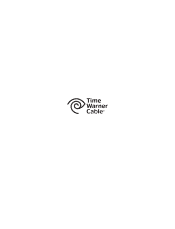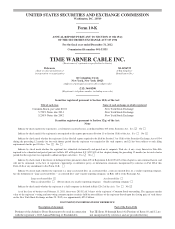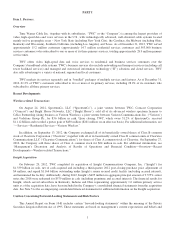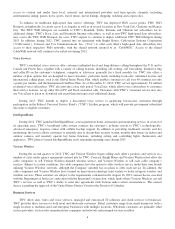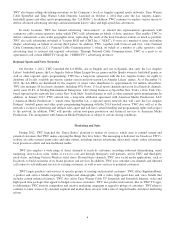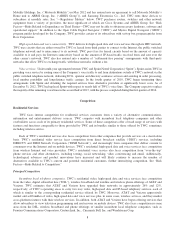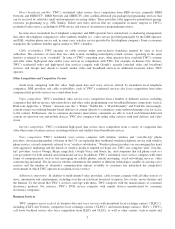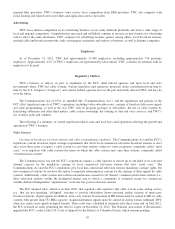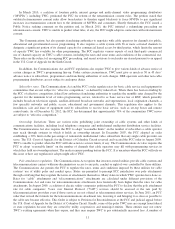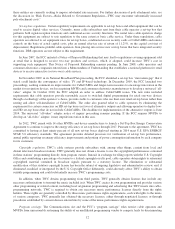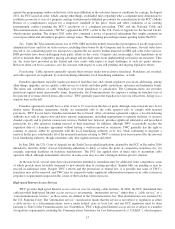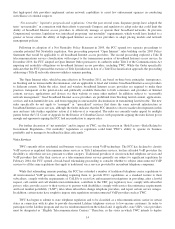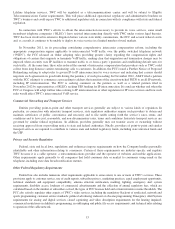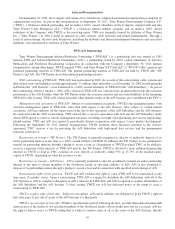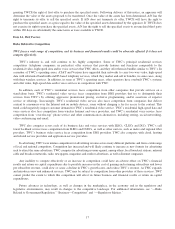Time Warner Cable 2012 Annual Report Download - page 17
Download and view the complete annual report
Please find page 17 of the 2012 Time Warner Cable annual report below. You can navigate through the pages in the report by either clicking on the pages listed below, or by using the keyword search tool below to find specific information within the annual report.Customer Care
TWC is continually improving its installation and service processes, including shortened service windows and
guaranteed on-time appointments. TWC, through its EZ Connects program, enables existing customers to self-install many of
the Company’s services without the need for a service appointment. To provide customers with more service and response
options, TWC has upgraded its call center platforms to allow customer calls to be routed more efficiently, and has invested in
its interactive voice response system and a broad set of online self-help tools. The Company also continues to focus on
improving reliability and the technical quality of its plant to avoid repeat trouble calls.
Technology
TWC’s cable systems employ a hybrid fiber coaxial cable, or “HFC,” network. TWC transmits signals on these systems
via laser-fed fiber optic cable from origination points known as “headends” and “hubs” to a group of distribution “nodes.”
TWC uses coaxial cable to deliver these signals from the individual nodes to the homes and businesses they serve. In many
locations, TWC has extended fiber and coaxial cable from the individual nodes to its customer’s site to support business data,
networking and wholesale transport services.
Historically, TWC has utilized local headends in each of its systems to receive, transcode and transmit video
signals. TWC is transitioning from the use of local headends to two national centers. These national centers leverage TWC’s
nationwide fiber backbone, which interconnects with TWC’s fiber-rich regional and metro rings, improving network
efficiency and reliability throughout the Company’s systems. Also, during 2012, TWC launched its own content delivery
network (“CDN”), which enables the Company to deliver managed IP video service to its customers without reliance on third
parties.
TWC believes that its network architecture is sufficiently flexible and extensible to support its current requirements.
However, TWC anticipates that it will need to continually use the bandwidth available to its systems more efficiently. To
accommodate increasing demands for greater capacity in its network, TWC has deployed a technology known as switched
digital video (“SDV”) in all of its service areas. SDV technology expands network capacity by transmitting on a given node
certain digital and HD video channels only when they are being watched by one or more customers served by that node.
Since it is generally the case that not all such channels are being watched at all times within any given group of customers,
SDV technology frees up capacity that can then be made available for other uses, including additional HD channels,
expanded VOD offerings, faster high-speed data connections, reliable voice quality and interactive services. TWC received
an Emmy award in 2008 for its efforts in SDV technology development. In addition to its use of SDV technology, TWC
expects that over the next several years it will continue to reclaim spectrum currently dedicated to the delivery of analog
video signals, thereby freeing additional capacity for other uses.
Suppliers
TWC contracts with certain third parties for goods and services related to the delivery of its video, high-speed data and
voice services.
Video programming. TWC carries local broadcast stations pursuant to the compulsory copyright provisions of the
Copyright Act of 1976, as amended, as well as under either the FCC “must carry” rules or a written retransmission consent
agreement with the relevant station owner. TWC has multi-year retransmission consent agreements in place with most of the
retransmission consent stations that it carries. For more information, see “—Regulatory Matters” below. Cable networks,
including premium networks and related VOD content, are carried pursuant to affiliation agreements. TWC generally pays a
monthly per subscriber fee for these cable services and for broadcast stations that elect retransmission consent. Payments to
the providers of some premium networks may be based on a percentage of TWC’s gross receipts from subscriptions to the
services. Generally, TWC obtains rights to carry VOD movies and events and to sell and/or rent online video programming
via the RR Video Store through iN Demand L.L.C., a company in which TWC holds a minority interest. In some instances,
TWC contracts directly with film studios for VOD carriage rights for movies. Such VOD content is generally provided to
TWC under revenue-sharing arrangements.
Set-top boxes, program guides and network equipment. TWC purchases set-top boxes and CableCARDs from a limited
number of suppliers, including Cisco Systems, Inc. (“Cisco Systems”), Google Inc. (“Google”) (which acquired Motorola
7


